Lifting aids help people with limited mobility or their caregivers with many everyday tasks. They are available in permanently installed form as ceiling lifts or wall lifts and as mobile lifting aids. Lifting aids make it easier to get up and move around safely and comfortably. Frequently, lifting lifts are used in the bathroom and bedroom. However, as an overhead lift, you can also overcome stairs or help with the transport from room to room.
Many people with limited mobility wish to regain lost independence. Lifting lifts can be a useful tool in this regard. There are various forms of lifting lifts, such as ceiling lifts, wall lifts or mobile lifting aids. The choice of the right model should be based on the respective area of application and the individual requirement profile.
What are lifting aids?
Lifting aids or lifting lifts are devices that help people with limited mobility to stand up or move around. There are lifting aids that can be used autonomously and there are solutions designed to facilitate care. Typical areas of application are the bedroom and the bathroom. Here, lifting aids make it possible to use the bathtub, go to the toilet independently or go to bed independently. There are mechanical lifting aids and those that are electrically operated. The latter can be used by the user without another assistant. Among the various designs, a distinction can be made between ceiling lifts, wall lifts or mobile lifting aids. They all have individual advantages and disadvantages.
Prices and costs
A lifting lift allows older people to enjoy a new lease on life. The initial cost depends on many different factors, so the lift can be significantly cheaper or more expensive than previously thought, depending on the equipment and adaptation.
Factors affecting price
The cost of a lift is made up of many different factors. Here it depends among other things on which model one decides on, which drive is needed and which additional equipment the lift should have. Furthermore, the price is also calculated according to the height to be overcome and the load capacity. In addition, the lift must be adapted to the structural and personal situation of the customer. Basically, therefore, a lift is in most cases a custom-made product. So, in summary, the following factors further drive up the overall price:
No. | Cost factors |
|---|---|
| 1. | Complexity and angle of inclination of the stairs |
| 2. | Number of steps |
| 3. | Effort during installation |
| 4. | Height to overcome |
| 5. | Additional equipment and optics |
| 6. | Weather resistance for outdoor installation |
| 7. | Load-bearing capacity and load-bearing capacity |
| 8. | Drive speed |
| 9. | Number of stops |
| 10. | Type of drive (electric motor, AC motor, AC motor, hydraulic drive |
The above factors thus ensure that manufacturers generally can not give a blanket price information. At the current time, the average price range for a lifting lift over one floor is around 5,000 to 10,000 €. Used models are already available for less than 3,000 €, but it is important to pay close attention to whether the model is suitable at all. When buying a new lift, a manufacturer can only provide a cost estimate after an on-site inspection. In addition, you should consider in advance whether the lift must also have special or adapted equipment. In this way, the manufacturer can prepare an offer perfectly tailored to your needs.
Acquisition costs
A lifting lift allows barrier-free access often without extensive remodeling of the living environment. It can be installed within a very short time and is cheaper to purchase than conventional elevators. When buying a lift, you should expect to pay at least 5,000 €. These prices are standard market prices and are not related to a single manufacturer. In the case of a single-family house with 1 floor and larger conversion costs, prices of up to 10,000 € can quickly arise. If the lift is installed for a wheelchair user, up to 4,000 € subsidy can be applied for and claimed from the care insurance, if a corresponding care degree is available.
Lift type | Stair form | Area | Price |
|---|---|---|---|
| Stairlift | straight stairs | Inside | 3,800 to 9,700 € |
| Stairlift | curved stairs | Inside | 8,000 to 15,000 € |
| Stairlift | straight stairs | Outside | 4,000 to 7,500 € |
| Platformlift | straight stairs | Inside | 9,000 to 15,000 € |
| Platformlift | curved stairs | Inside | 12,000 to 25,000 € |
| Platformlift | straight stairs | Outside | 9,000 to 15,000 € |
| Platformlift | curved stairs | Outside | 15,000 to 25,000 € |
| Lifting Platform | Height up to 1.79m | Outside | 8,000 to 15,000 € |
| Lifting Platform | Height up to 3m | Outside | from 17,500 € |
The price of a lifting lift depends on various factors such as load capacity, travel speed, number of stopping points, height, type of drive, model and appearance. Lifts with a rain cover are understandably more expensive than those with an open cabin. The real purchase costs can be determined very accurately by obtaining several cost estimates from different lift manufacturers -and service providers. An incalculable size remains however the costs of the necessary rebuilding measures at the single-family dwelling. If larger excavations are necessary at the single-family dwelling, additional costs can develop. Therefore, before buying a lift, find out about “all” the costs involved and financial subsidies. In addition to the care cost subsidy for measures to improve the individual living environment, the state-subsidized KfW Bank promotes measures to reduce barriers with favorable loans of up to 50,000 €.
Prices and customization options vary widely from manufacturer to manufacturer. There are no blanket price quotations such as a price per 1 meter of height or square meter of cabin area. Generally speaking, the higher a lift is and the more weight it can transport, the more expensive it is. For each additional meter, you should expect to pay at least 2,000 € more, not including costs for conversion work. A lift that is attached to the outside of the facade, is about 2 meters high, has 2 holding points, moves via a hydraulic drive and can be used by one wheelchair user or a maximum of 4 people at the same time should cost at least 8,000 € including installation. The purchase is costly and should be carefully planned. With a price comparison over treppenlifto.de much money can be saved. You will receive up to three free and non-binding offers from lifting lift providers in your region with a request, which you can compare at your leisure and without risk.
Costs for maintenance and servicing
Lift lifts are low-emission, durable, lightweight and space-saving. A hoist lift only needs to have its oil and seals changed every 5 years. The material required for this is freely available and costs around 100 €. For the professional implementation of the oil -and seal change, one should expect costs of about 500 €. The cost of labor for maintenance is about 1,000 €. As a rule, a partial or full maintenance contract is concluded with the lift manufacturer from whom the lift is purchased to cover maintenance for a period of five or ten years. The costs for maintenance, inspection, cleaning, lubrication, adjustment work and the replacement of wear parts are then usually regulated on a flat-rate basis.
Energy costs
The energy costs for a lift consist of the consumption during travels and standby times. For a lift in a single-family house with 1,500 trips per year, i.e. about 4 trips per day, one should expect energy costs of 200 kWh standby power and 100 kWh travel power. At an electricity price of 0.26 €/kWh, this results in annual costs of about 78 €.
Lifting devices in single-family houses stand still 99% of the time. The energy costs therefore depend primarily on how much the elevator is used, whether the drive installed is suitable for the particular usage situation and what height the lift has to overcome. As a rule, more than 50% of the electricity consumed by lift systems is used in standby mode. To save energy costs, you should make sure when buying that LED lamps are installed instead of halogen or incandescent lamps and that a timer function exists for lighting and electronics.
Rent or pay in installments
Many manufacturers also offer the possibility of renting the lift or pay off monthly by installment. Here it is advisable to compare the prices of the various providers in detail and in peace with each other – this saves money. Furthermore, it can’t hurt to talk to your bank advisor about a financing model. In some cases, a bank loan may have lower interest rates than a loan through the respective lift manufacturer. In addition, an on-site inspection and estimate should be non-binding and free of charge.
Ceiling lifts as lifting aids
Ceiling lifts are, as the name suggests, attached to the ceiling. Typical applications are the bedroom and the bathroom. Ceiling lifts differ from other lifting aids, however, by the fact that they allow more than just raising or moving. In fact, many ceiling lifts have a rail system that allows them to be transported from room to room. This rail system can be designed very complex according to individual needs.
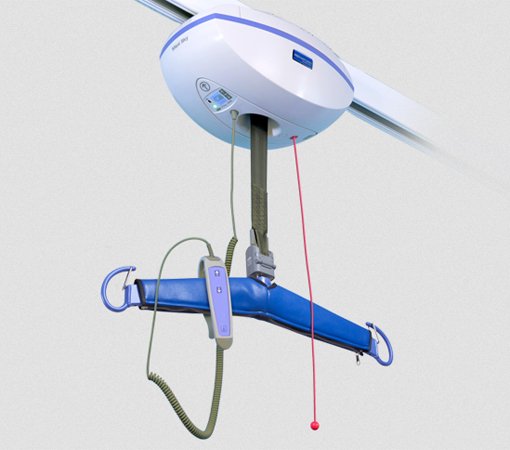 PhotosSource: Arjohuntleigh.ie | Press image | © Copyright by ArjoHuntleigh Ireland Ltd
PhotosSource: Arjohuntleigh.ie | Press image | © Copyright by ArjoHuntleigh Ireland LtdVarious elements, such as turnouts, can be used to make an entire apartment accessible by ceiling lift. In combination with an electric drive, people with mobility impairments can thus move around their apartment completely self-sufficiently. Even stairs are no obstacle, because they can also be passed with an overhead lift. Without electric drive, the ceiling lift can facilitate the work of caregivers.
Wall lift as a lifting lift
Wall lifts typically do not use the rail system common with overhead lifts. Instead, wall lifts are permanently installed at individual points. For example, a wall lift at the bedside can allow autonomous transfer to the wheelchair. A wall lift in the bathroom can enable independent use of the bathtub. However, a normal wall lift cannot be used to transfer from room to room. Wall lifts with a rail system are an exception. In principle, this is a ceiling lift, which is usually not attached to the ceiling, but in the wall for reasons of load-bearing capacity.
Advantages and disadvantages of permanently installed lifting aids
Permanently installed lifting aids, such as ceiling lifts and wall lifts, are perceived as particularly safe. They effectively assist people with mobility impairments in accomplishing a wide range of everyday tasks. In the home, permanently installed lifting aids take up hardly any space. They cannot get in the way and are therefore equally convenient for all residents. Rail systems allow maximum freedom of movement in the process.
 PhotosSource: ascendor.at | Press image | PLK7
PhotosSource: ascendor.at | Press image | PLK7By means of an electric drive, users can move around their home completely independently. A disadvantage, however, is the complex assembly. This makes ceiling lifts and wall lifts expensive investments. They also lack the flexibility of a mobile solution. Although ceiling lifts can be used in other rooms, the appropriate bracket or rail must be available there as well. Mobile lifting aids, on the other hand, can be used anywhere. There are even models that can be folded and taken along.
Mobile lifting aids
Mobile lifting aids are not permanently mounted on walls or ceilings. As a rule, mobile lifting aids have wheels and can thus be used flexibly in several places and rooms. A distinction is made between active and passive lifting aids.
 PhotosSource: wikipedia.org
PhotosSource: wikipedia.orgActive lifting lifts assist the user by means of an electric motor, similar to the ceiling lift. Therefore, they can also be used alone and independently. Mobile lifting aids are also available in foldable form. In this case, the lifting lift can be easily taken along and transported in a car, for example.
Prices, costs and offers
Depending on the form and design, the prices of lifting lifts vary considerably. The most expensive are, of course, rail systems, for example, ceiling lifts. However, they offer the greatest benefit and the most application possibilities in return. Prices in this range start at around 5,000 €. If several rooms are to be opened up, however, the costs can also rise to over 10,000 €.
Significantly cheaper are wall lifts or lifting aids that are permanently installed without a rail system. The cheapest alternative, however, are mobile lifting aids, especially of passive design. They are already available for less than a hundred €. It may be possible to save money by buying a used lifting aid. If the need is temporary, renting may also be an option.



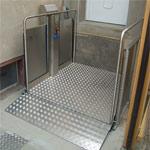
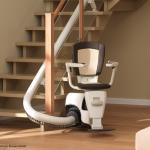
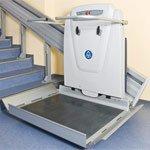

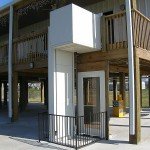




Hello, we have to move out of our house into an assisted living facility and would like to sell our stairlift (garaventa-about 5-6 years old), is this possible-if so-how?
with kind regards
G. Engelbrecht
Seeking a mobile lift for my severely disabled grandchild (7 yrs) to relieve the burden on my caregiving daughter (mother):
Lifting from the floor
Lifting from bed
Lifting into wheelchair
The first floor apartment has only narrow door widths.
Children’s room: 69 cm, bathroom: 56 cm.
Is there a push-through lift for this?